Plasticity and Ductile Fracture of High-Strength Steel Center-Holed Plates under Tension
Abstract
:1. Introduction
2. Material Plasticity
2.1. Tensile Specimens
2.2. Full-Range True Stress–Strain Relations
2.3. FE Analysis on Plate Specimens
3. Ductile Fracture Criterion
3.1. Uncoupled Ductile Fracture
3.2. Tensile Fracture of Plate Specimens
4. Modelling of CH Specimens
4.1. Force-Displacement Curves
4.2. Fracture Modes
4.3. Plastic Strain Distribution Close to Fracture
4.4. Tensile Strength of Net Cross-Section
5. Conclusions
- (1)
- The combined linear and power stress–strain law can be used to describe the post-necking stress–strain relations of S700MC and S960Q. The weighting factors in the combined law were calibrated to be −0.1 and −0.2 for S700MC and S960Q, respectively.
- (2)
- The uncoupled ductile fracture models were calibrated based on the Tracey–Rice damage criterion with the proposed post-necking degraded stress–strain relations. The fracture parameter was calibrated as 2.0 for S700MC and S960Q, proved by the good agreements of the FE analysis and experimental results of plate and CH specimens.
- (3)
- The fracture failure modes of plate and CH specimens were well predicted using the proposed fracture models. The maximum equivalent plastic strains around the bolt hole near the initial fracture were 0.90 and 0.85 for S700MC and S960Q, respectively.
- (4)
- The equation in EN 1993-1-1 gave conservative predictions for net cross-sectional tensile strength of the CH specimens.
Author Contributions
Funding
Data Availability Statement
Conflicts of Interest
References
- Jensen, L.; Bloomstine, M.L. Application of high strength steel in super long span modern suspension bridge design. In Proceedings of the Nordic Steel Construction Conference, Malmö, Sweden, 18–20 September 2009; pp. 494–501. [Google Scholar]
- Tran, A.T.; Veljkovic, M.; Rebelo, C.; da Silva, L.S. Resistance of cold-formed high strength steel circular and polygonal sections-Part 1: Experimental investigations. J. Constr. Steel Res. 2016, 120, 245–257. [Google Scholar] [CrossRef]
- Ban, H.Y.; Shi, G. A review of research on high-strength steel structures. Proc. Inst. Civ. Eng.-Struct. Build. 2017, 171, 625–641. [Google Scholar] [CrossRef]
- Može, P.; Beg, D.; Lopatič, J. Net cross-section design resistance and local ductility of elements made of high strength steel. J. Constr. Steel Res. 2007, 63, 1431–1441. [Google Scholar] [CrossRef]
- Može, P.; Beg, D. High strength steel tension splices with one or two bolts. J. Constr. Steel Res. 2010, 66, 1000–1010. [Google Scholar] [CrossRef]
- Može, P.; Beg, D. Investigation of high strength steel connections with several bolts in double shear. J. Constr. Steel Res. 2011, 67, 333–347. [Google Scholar] [CrossRef]
- Može, P. Bearing strength at bolt holes in connections with large end distance and bolt pitch. J. Constr. Steel Res. 2018, 147, 132–144. [Google Scholar] [CrossRef]
- Wang, Y.B.; Lyu, Y.F.; Li, G.Q.; Liew, J.Y.R. Behavior of single bolt bearing on high strength steel plate. J. Constr. Steel Res. 2017, 137, 19–30. [Google Scholar] [CrossRef]
- Wang, Y.B.; Lyu, Y.F.; Li, G.Q.; Liew, J.Y.R. Bearing-strength of high strength steel plates in two-bolt connections. J. Constr. Steel Res. 2019, 155, 205–218. [Google Scholar] [CrossRef]
- Lyu, Y.F.; Wang, Y.B.; Li, G.Q.; Jiang, J. Numerical analysis on the ultimate bearing resistance of single-bolt connection with high strength steels. J. Constr. Steel Res. 2019, 153, 118–129. [Google Scholar] [CrossRef]
- Feldmann, M.; Schaffrath, S. Assessing the net section resistance and ductility requirements of EN 1993-1-1 and EN 1993-1-12. Steel Constr. 2017, 10, 354–364. [Google Scholar] [CrossRef]
- Feldmann, M.; Schaffrath, S. Application of damage theory to structures made from high-strength steels. Steel Constr. 2018, 11, 257–263. [Google Scholar] [CrossRef]
- Achouri, M.; Germain, G.; Santo, P.D.; Saidane, D. Experimental characterization and numerical modeling of micromechanical damage under different stress states. Mater. Des. 2013, 50, 207–222. [Google Scholar] [CrossRef]
- Achouri, M.; Germain, G.; Santo, P.D.; Saidane, D. Experimental and numerical analysis of micromechanical damage in the punching process for High-Strength Low-Alloy steels. Mater. Des. 2014, 56, 657–670. [Google Scholar] [CrossRef]
- Yan, R.; Xin, H.H.; Veljkovic, M. Ductile fracture simulation of cold-formed high strength steel using GTN damage model. J. Constr. Steel Res. 2021, 184, 106832. [Google Scholar] [CrossRef]
- Yan, R.; Xin, H.H.; Mela, K.; Bamby, H.E.; Veljkovic, M. Fracture simulation of welded RHS X-joints using GTN damage model. Adv. Struct. Eng. 2022. [Google Scholar] [CrossRef]
- Džugan, J.; Španiel, M.; Prantl, A.; Konopík, P.; Růžička, J.; Kuželka, J. Identification of ductile damage parameters for pressure vessel steel. Nucl. Eng. Des. 2018, 328, 372–380. [Google Scholar] [CrossRef]
- Wen, H.J.; Mahmoud, H. New model for ductile fracture of metal alloys. I: Monotonic loading. J. Eng. Mech. 2016, 142, 04015088. [Google Scholar] [CrossRef]
- Wen, H.J.; Mahmoud, H. Simulation of block shear fracture in bolted connections. J. Constr. Steel Res. 2017, 134, 1–16. [Google Scholar] [CrossRef]
- Li, W.C.; Liao, F.F.; Zhou, T.H.; Askes, H. Ductile fracture of Q460 steel: Effects of stress triaxiality and Lode angle. J. Constr. Steel Res. 2016, 123, 1–17. [Google Scholar] [CrossRef]
- Li, W.C.; Jing, Y.; Zhou, T.H.; Xing, G.H. A new ductile fracture model for structural metals considering effects of stress state, strain hardening and micro-void shape. Thin-Walled Struct. 2022, 176, 109280. [Google Scholar] [CrossRef]
- Yu, R.; Li, X.; Yue, Z.; Li, A.; Zhao, Z.; Wang, X.; Zhou, H.; Lu, T.J. Stress state sensitivity for plastic flow and ductile fracture of L907A low-alloy marine steel: From tension to shear. Mater. Sci. Eng. A 2022, 835, 142689. [Google Scholar] [CrossRef]
- EN 10149-2; Hot Rolled Flat Products Made of High Yield Strength Steels for Cold Forming—Part 2: Technical Delivery Conditions for Thermo-Mechanically Rolled Steels. European Committee for Standardization: Brussels, Belgium, 2013.
- EN 10025-6; Hot Rolled Products of Structural Steels—Part 6: Technical Delivery Conditions for Flat Products of High Yield Strength Structural Steels in the Quenched and Tempered Condition. European Committee for Standardization: Brussels, Belgium, 2004.
- Turán, P.; Horváth, L. Experimental behavior of tension plates with center hole made from high strength steel. In Proceedings of the Nordic Steel Construction Conference, Tampere, Finland, 23–25 September 2015. [Google Scholar]
- Feldmann, M.; Schillo, N.; Schaffrath, S.; Virdi, K.; Tuominen, N.; Veljkovic, M.; Pavlovic, M.; Manoleas, P.; Heinisuo, M.; Mela, K.; et al. Rules on High Strength Steel; Final Report, RFSR-CT-2012-00036; European Commission: Luxembourg, 2016.
- Hertelé, S.; De Waele, W.; Denys, R. A generic stress-strain model for metallic materials with two-stage strain hardening behavior. Int. J. Non-Linear Mech. 2011, 46, 519–531. [Google Scholar] [CrossRef]
- Paredes, M.; Wierzbicki, T.; Zelenak, P. Prediction of crack initiation and propagation in X70 pipeline steels. Eng. Fract. Mech. 2016, 168, 92–111. [Google Scholar] [CrossRef]
- Roth, C.C.; Mohr, D. Ductile fracture experiments with locally proportional loading histories. Int. J. Plast. 2016, 79, 328–354. [Google Scholar] [CrossRef]
- Mu, L.; Zang, Y.; Wang, Y.; Li, X.L.; Stemler, P.M.A. Phenomenological uncoupled ductile fracture model considering different void deformation modes for sheet metal forming. Int. J. Mech. Sci. 2018, 141, 408–423. [Google Scholar] [CrossRef]
- Ling, Y. Uniaxial true stress-strain after necking. AMP J. Technol. 1996, 5, 37–48. [Google Scholar]
- Hollomon, J.H. Tensile deformation. Trans AIME 1945, 162, 268–290. [Google Scholar]
- Yang, F.; Veljkovic, M. Damage model calibration for S275 and S690 steels. Ce/Papers 2019, 3, 262–271. [Google Scholar] [CrossRef]
- Yang, F.; Veljkovic, M.; Liu, Y.Q. Ductile damage model calibration for high-strength structural steels. Constr. Build. Mater. 2020, 263, 120632. [Google Scholar] [CrossRef]
- Abaqus Analysis User’s Guide, Version 6.13; Dassault Systèmes Simulia Corp.: Providence, RI, USA, 2013.
- Kanvinde, A.M.; Deierlein, G.G. The void growth model and the stress modified critical strain model to predict ductile fracture in structural steels. J. Struct. Eng. 2006, 132, 1907–1918. [Google Scholar] [CrossRef]
- Jia, L.J.; Kuwamura, H. Ductile fracture simulation of structural steels under monotonic tension. J. Struct. Eng. 2014, 140, 04013115. [Google Scholar] [CrossRef]
- Liao, F.; Wang, M.; Tu, L.; Wang, J.; Lu, L. Micromechanical fracture model parameter influencing factor study of structural steels and welding materials. Constr. Build. Mater. 2019, 215, 898–917. [Google Scholar] [CrossRef]
- Han, Q.; Jiang, K.; Wen, J.; Yang, L. Micromechanical fracture models of Q345 steel and its weld. J. Mater. Civ. Eng. 2019, 31, 04019268. [Google Scholar] [CrossRef]
- Rice, J.R.; Tracey, D.M. On the enlargement of voids in triaxial stress fields. J. Mech. Phys. Solids 1969, 17, 201–217. [Google Scholar] [CrossRef]
- EN 1993-1-1; Design of Steel Structures—Part 1-1: General Rules and Rules for Buildings. European Committee for Standardization: Brussels, Belgium, 2005.

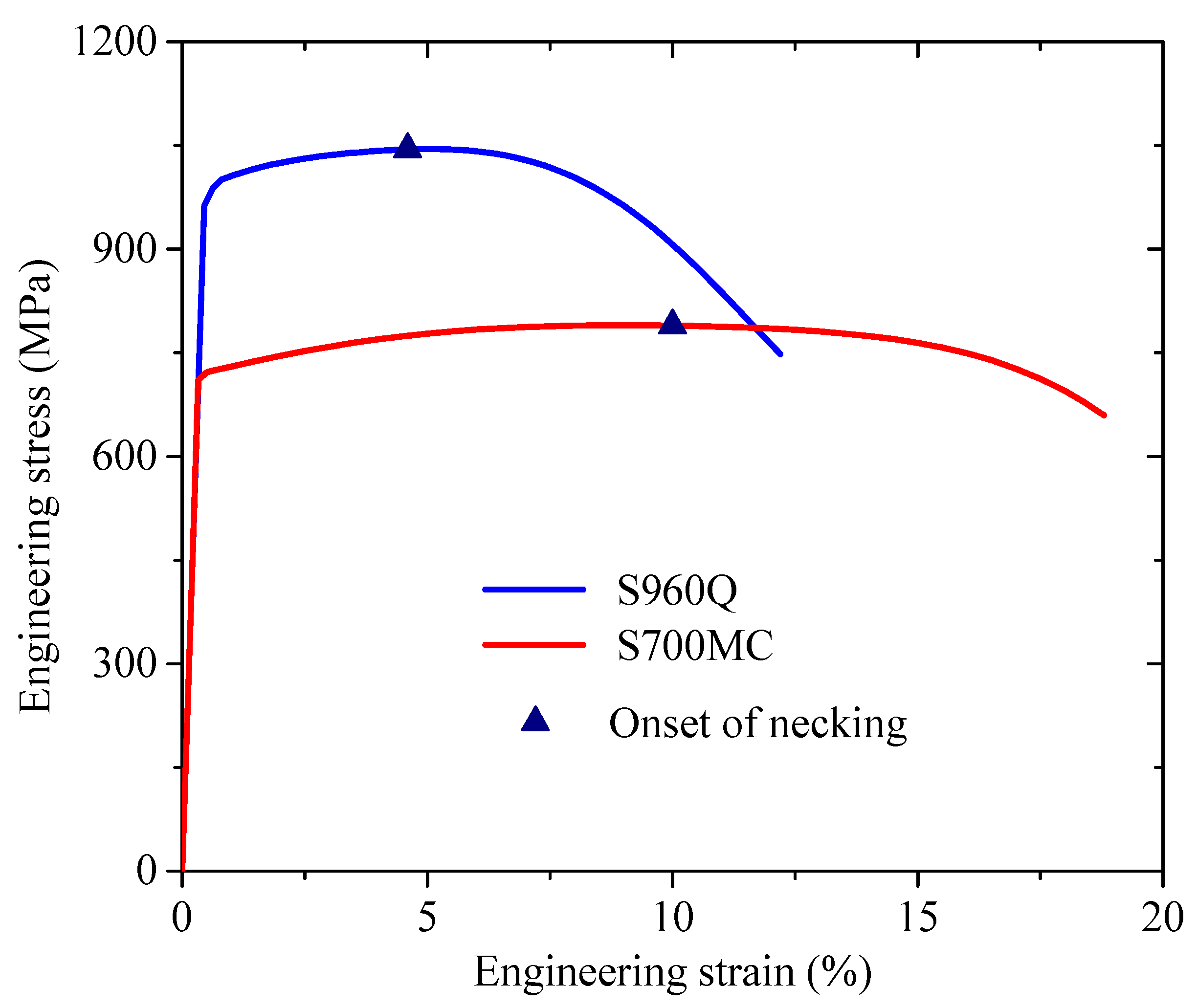
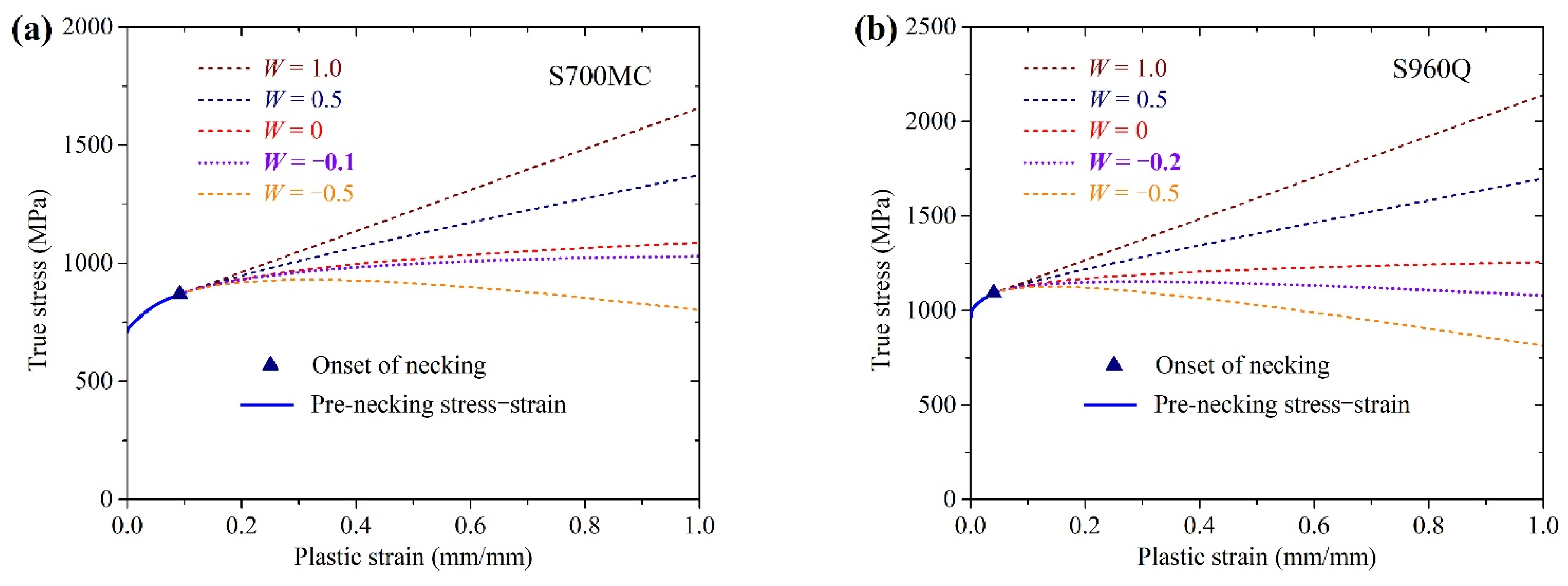
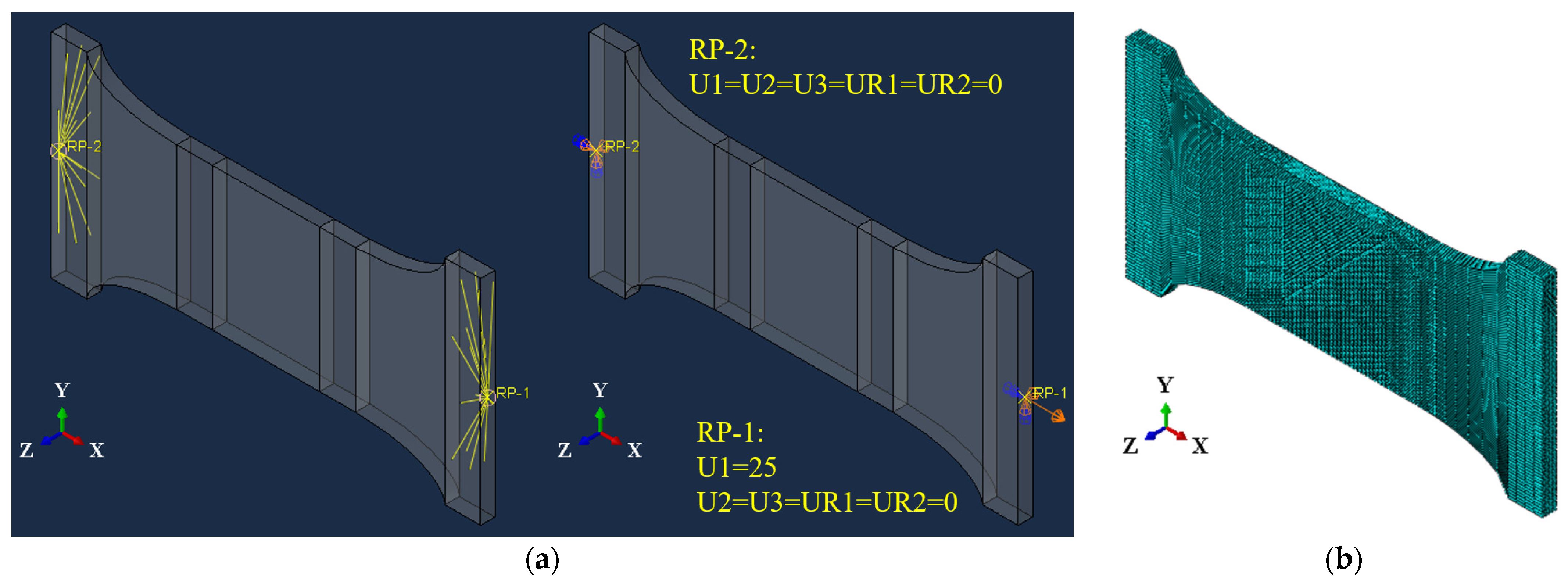
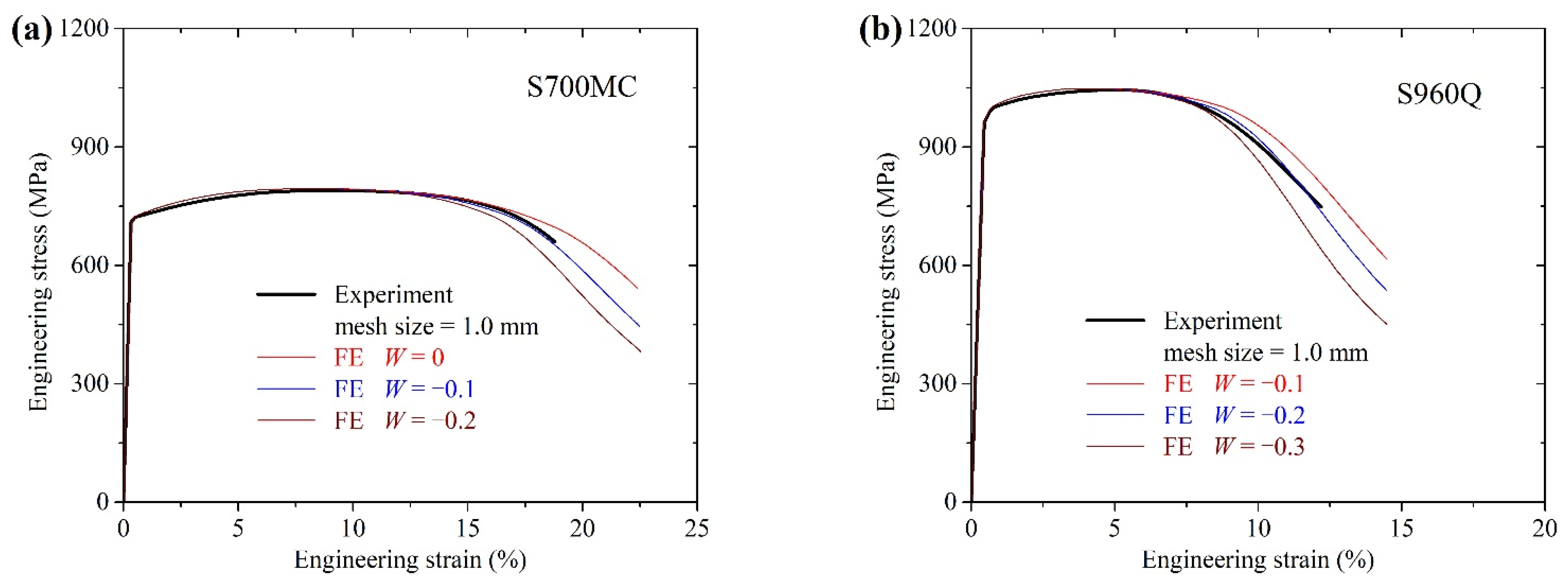
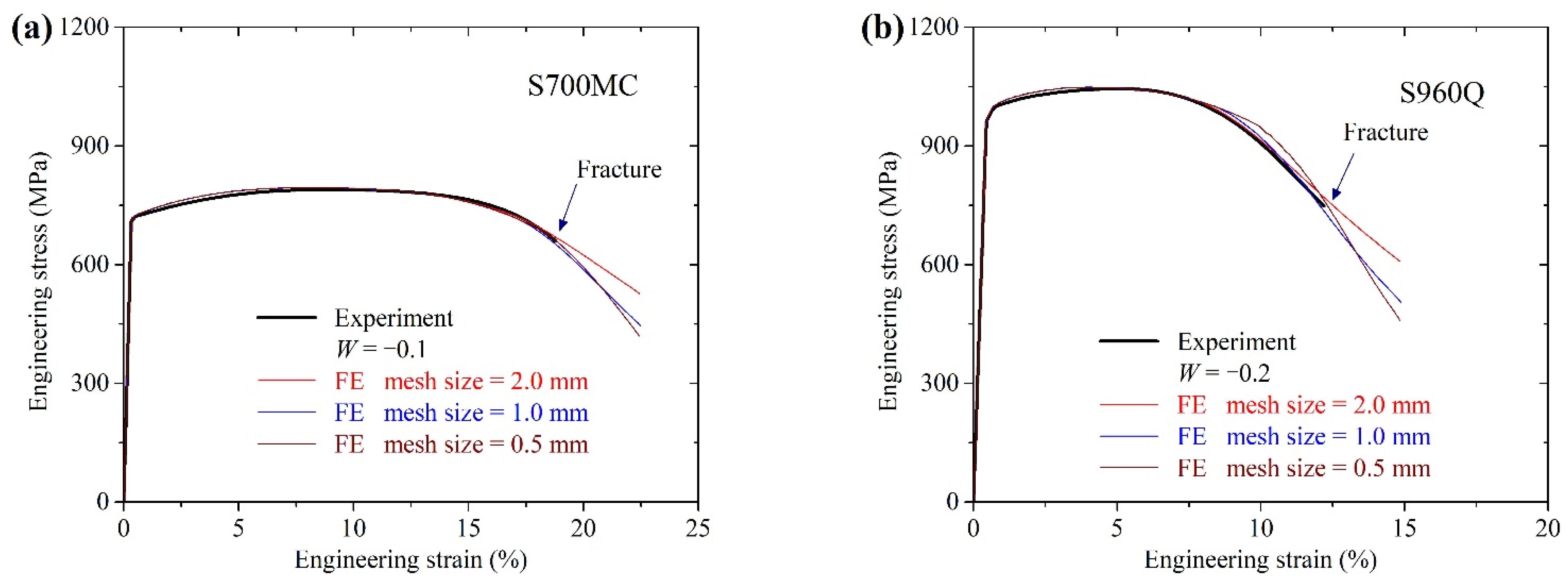
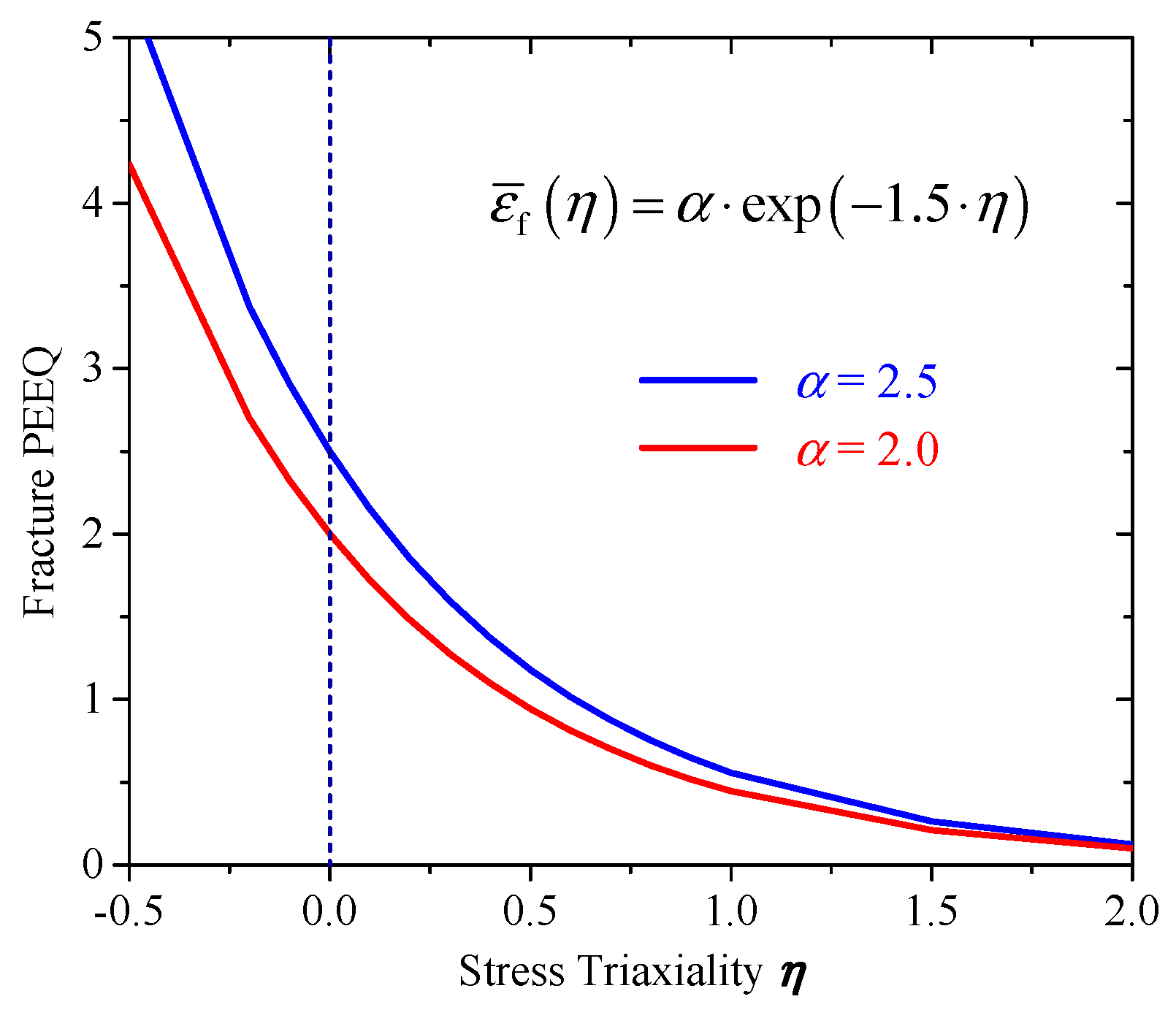
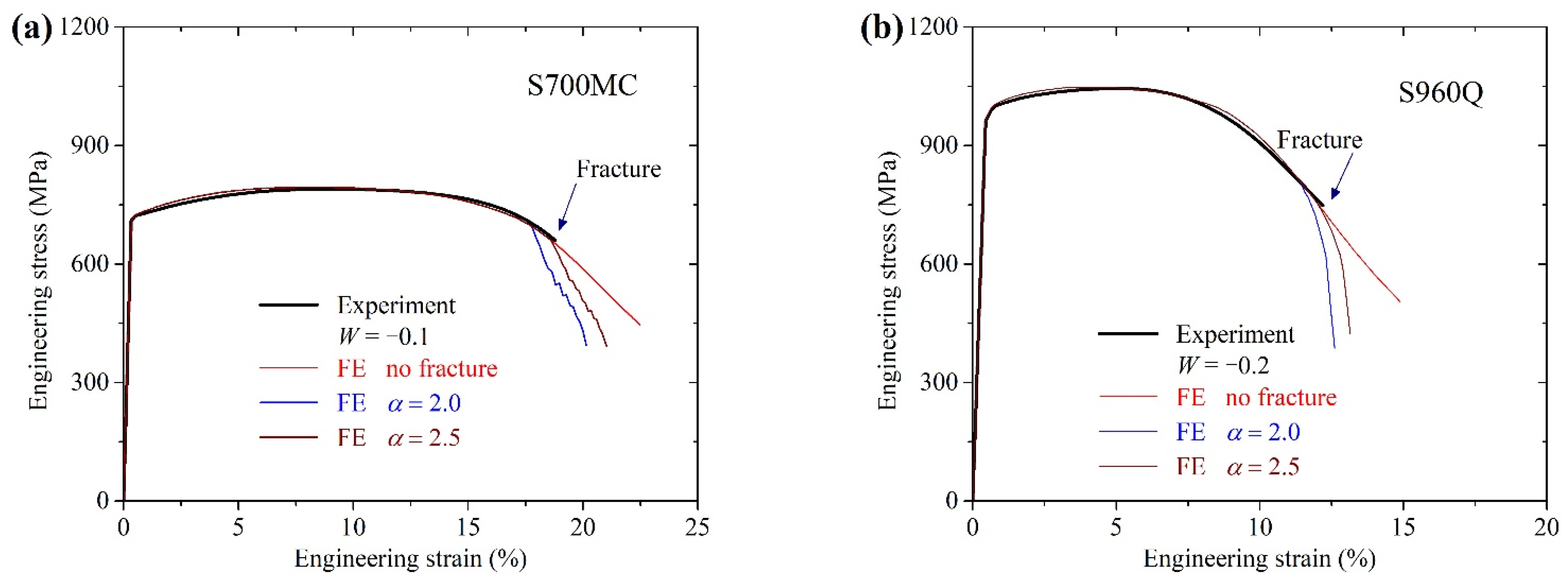
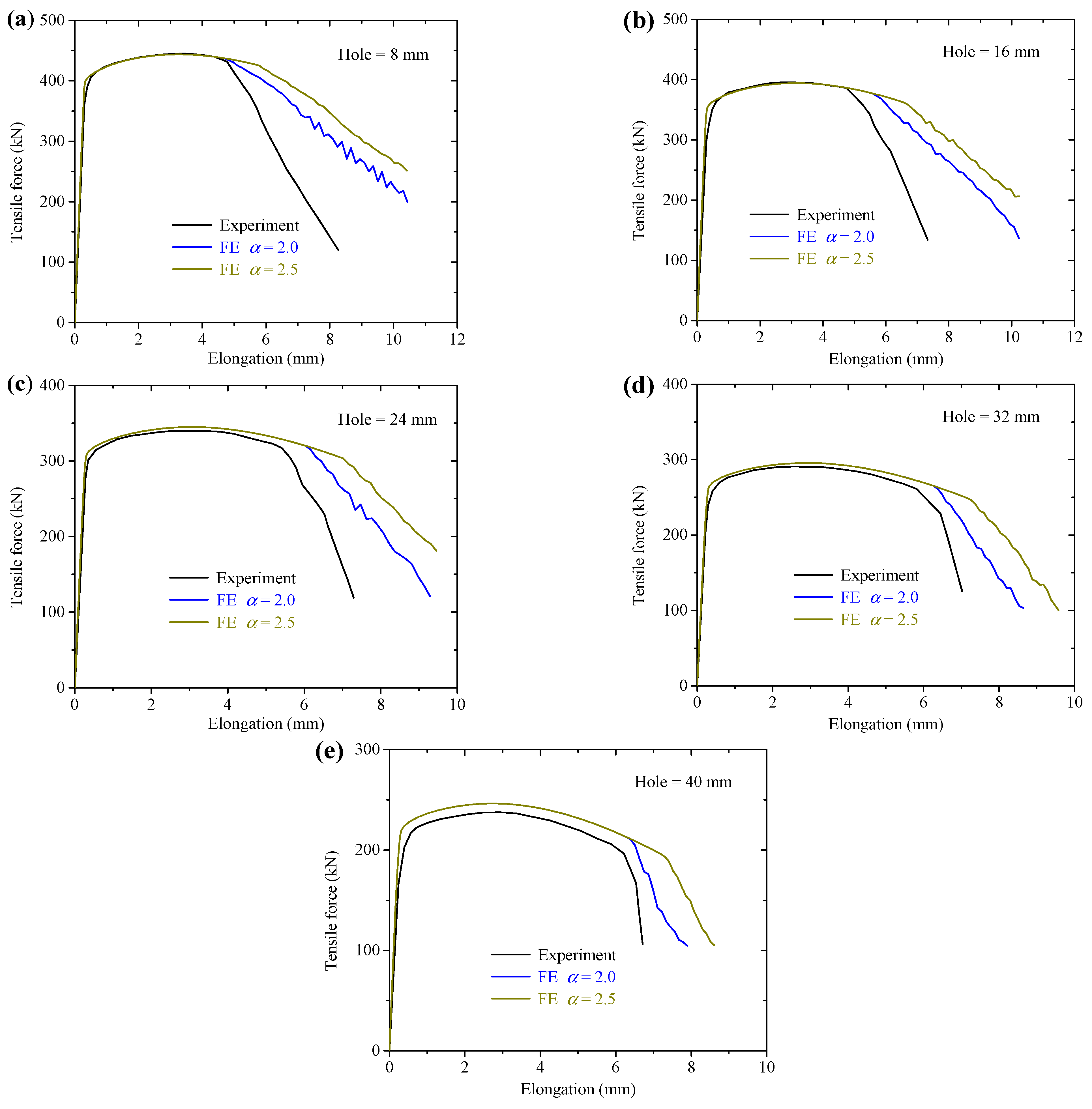
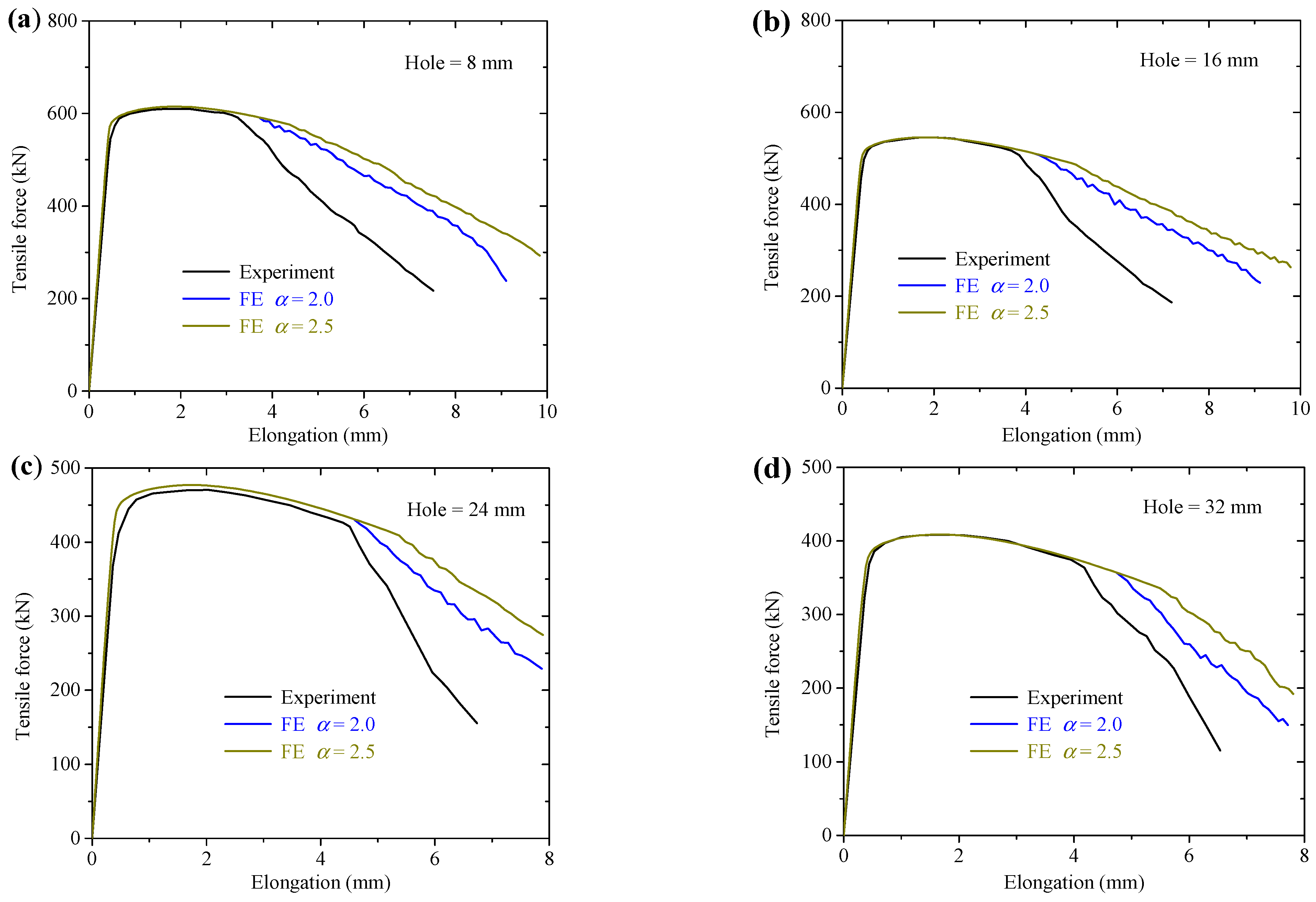
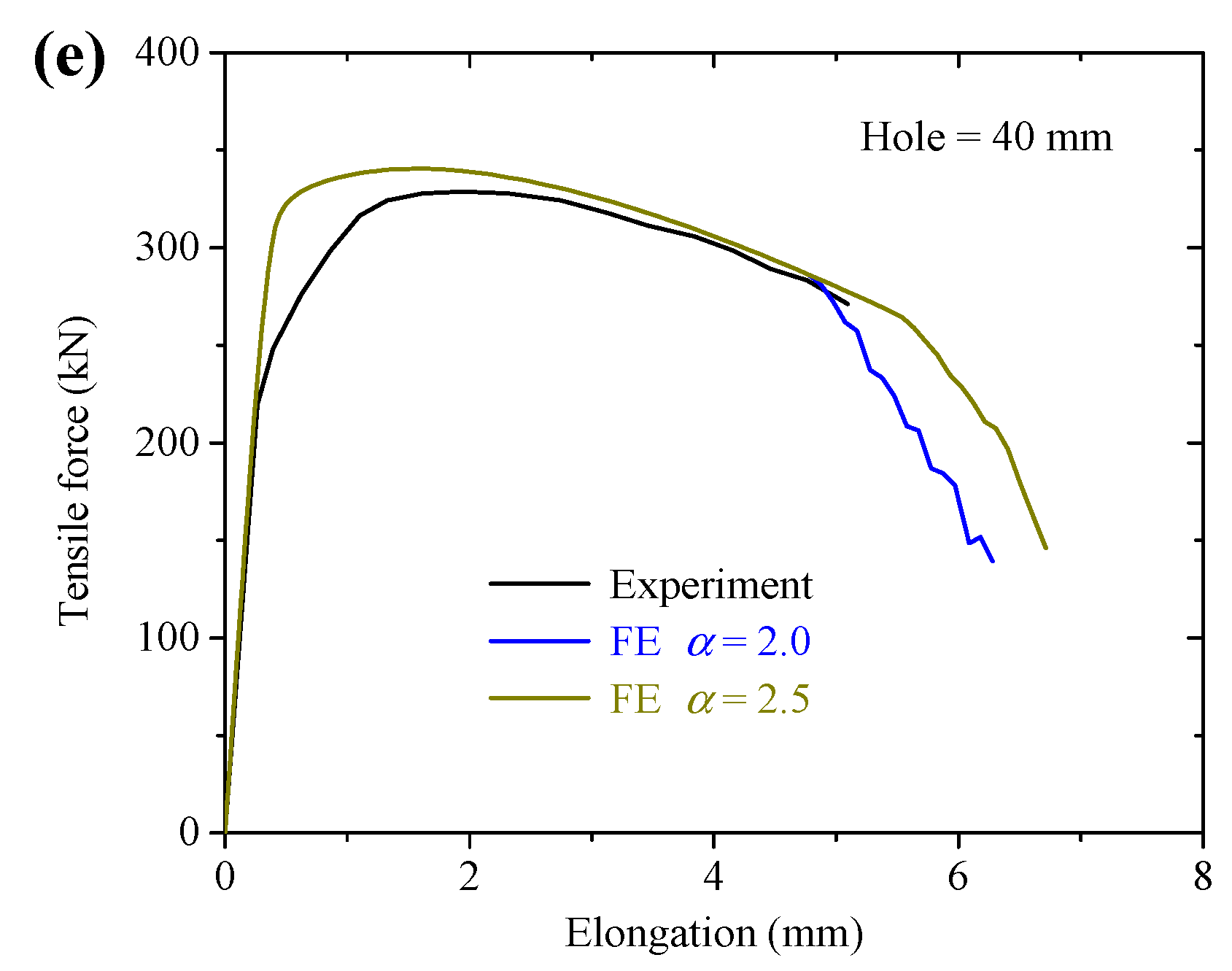
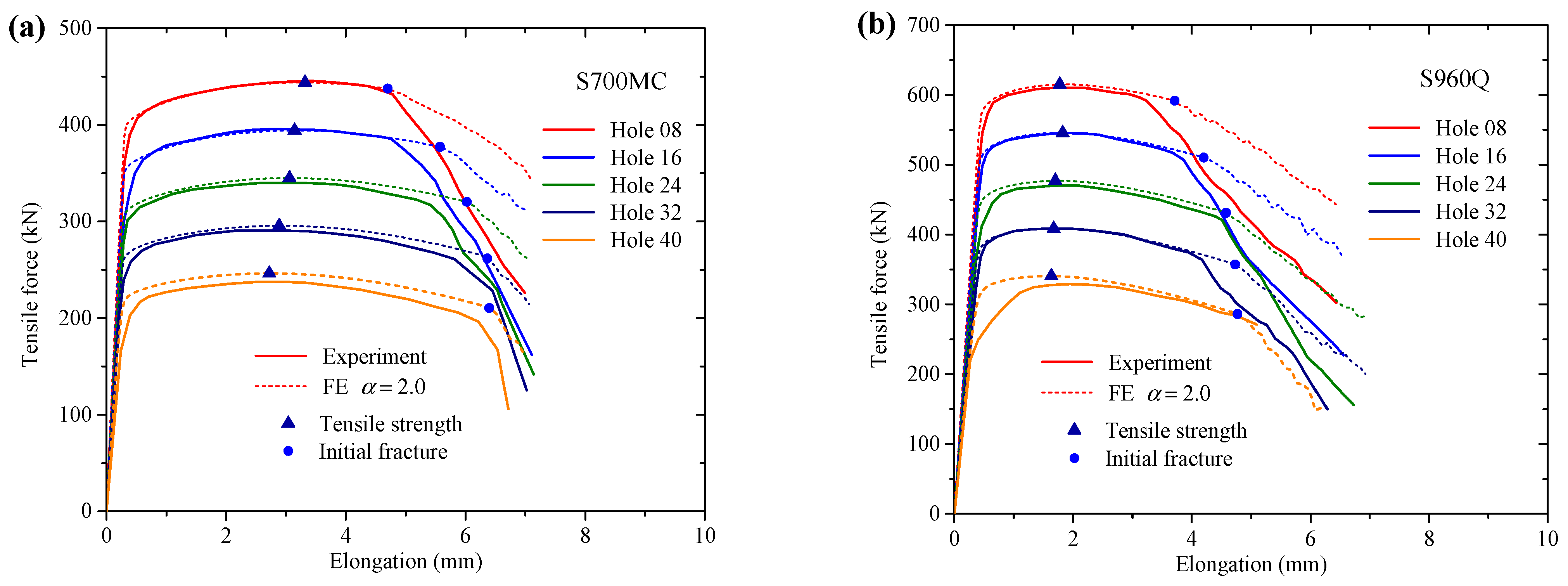
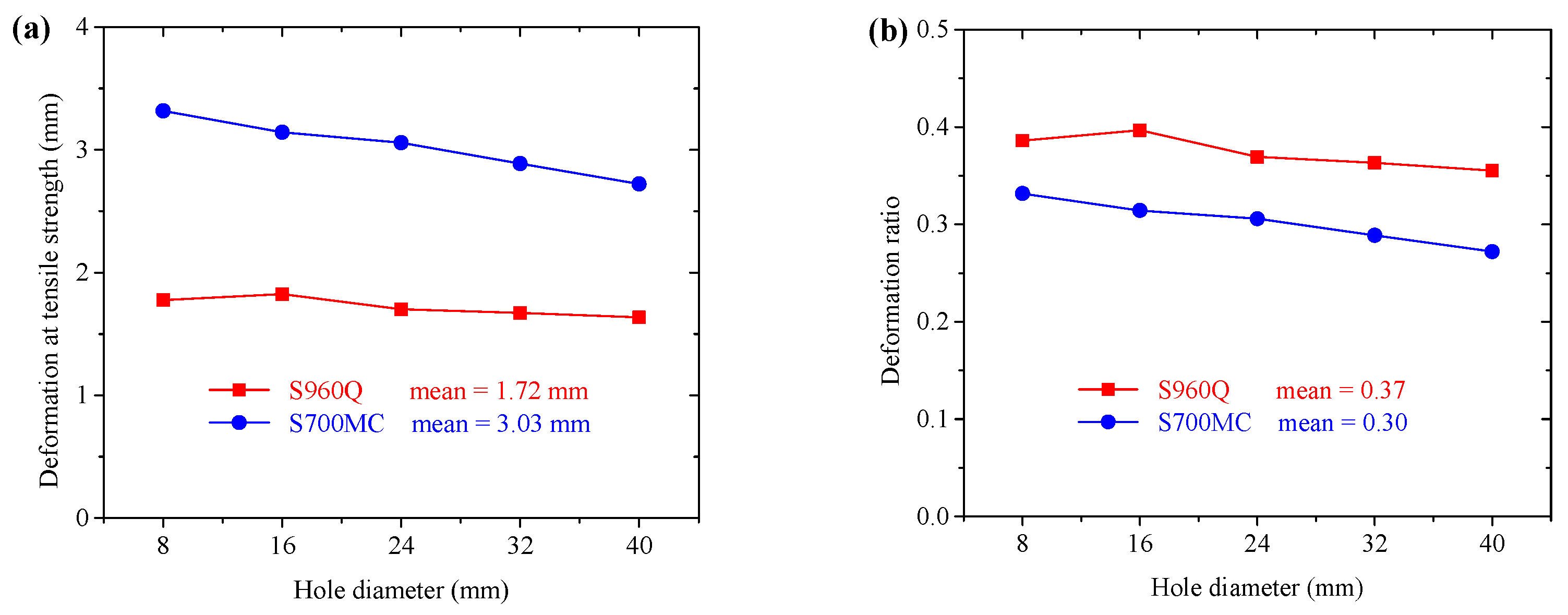
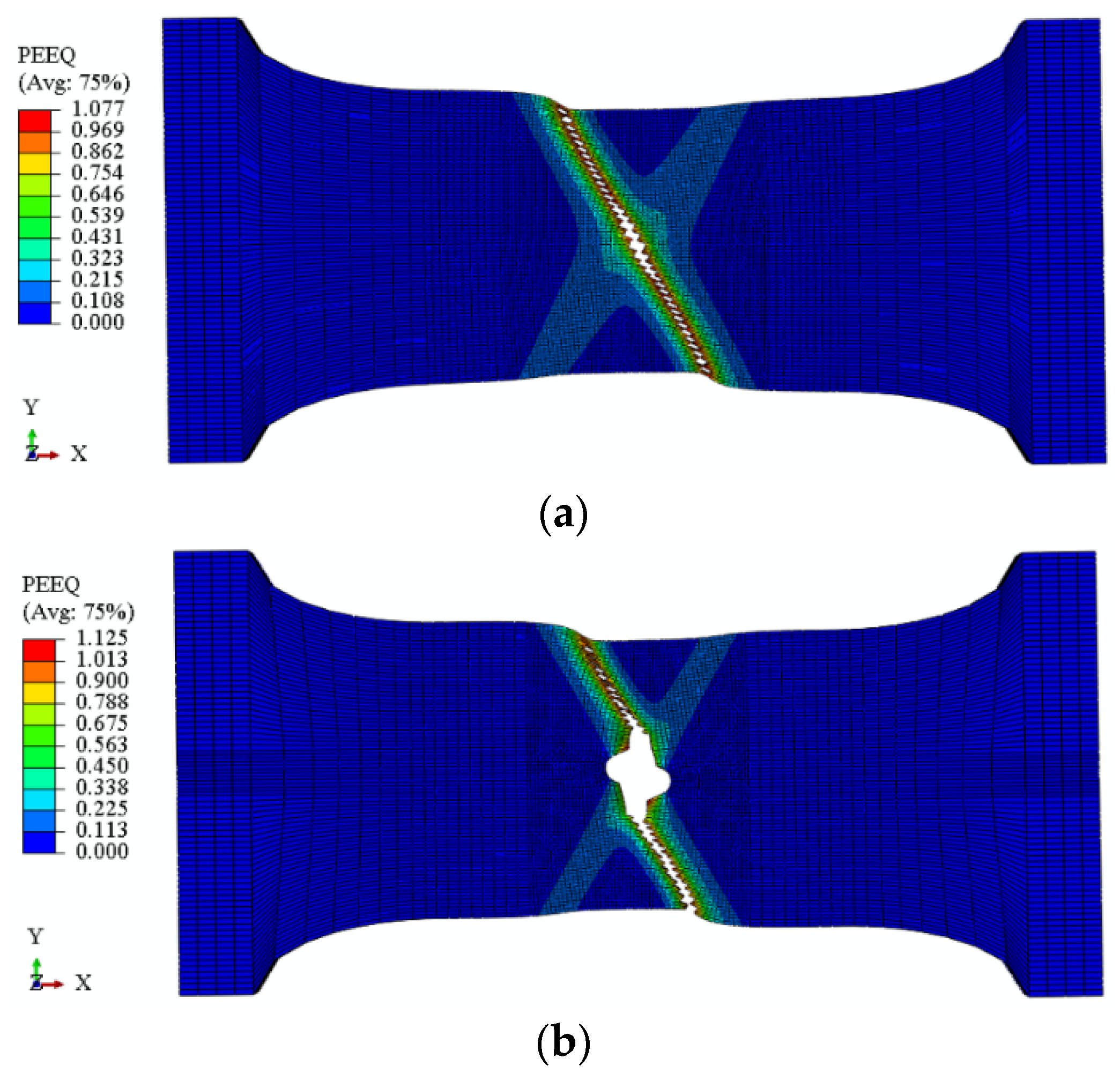
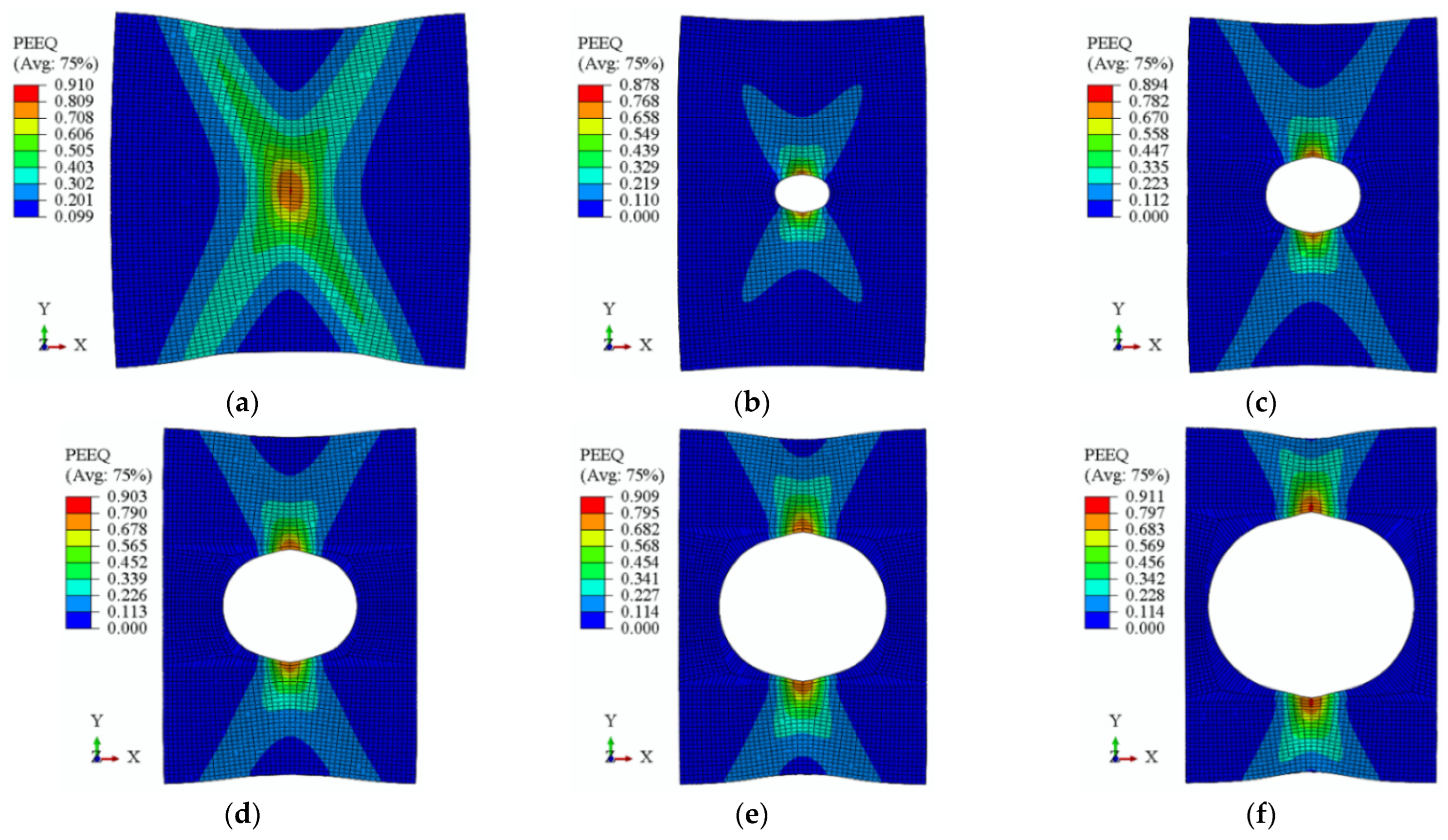
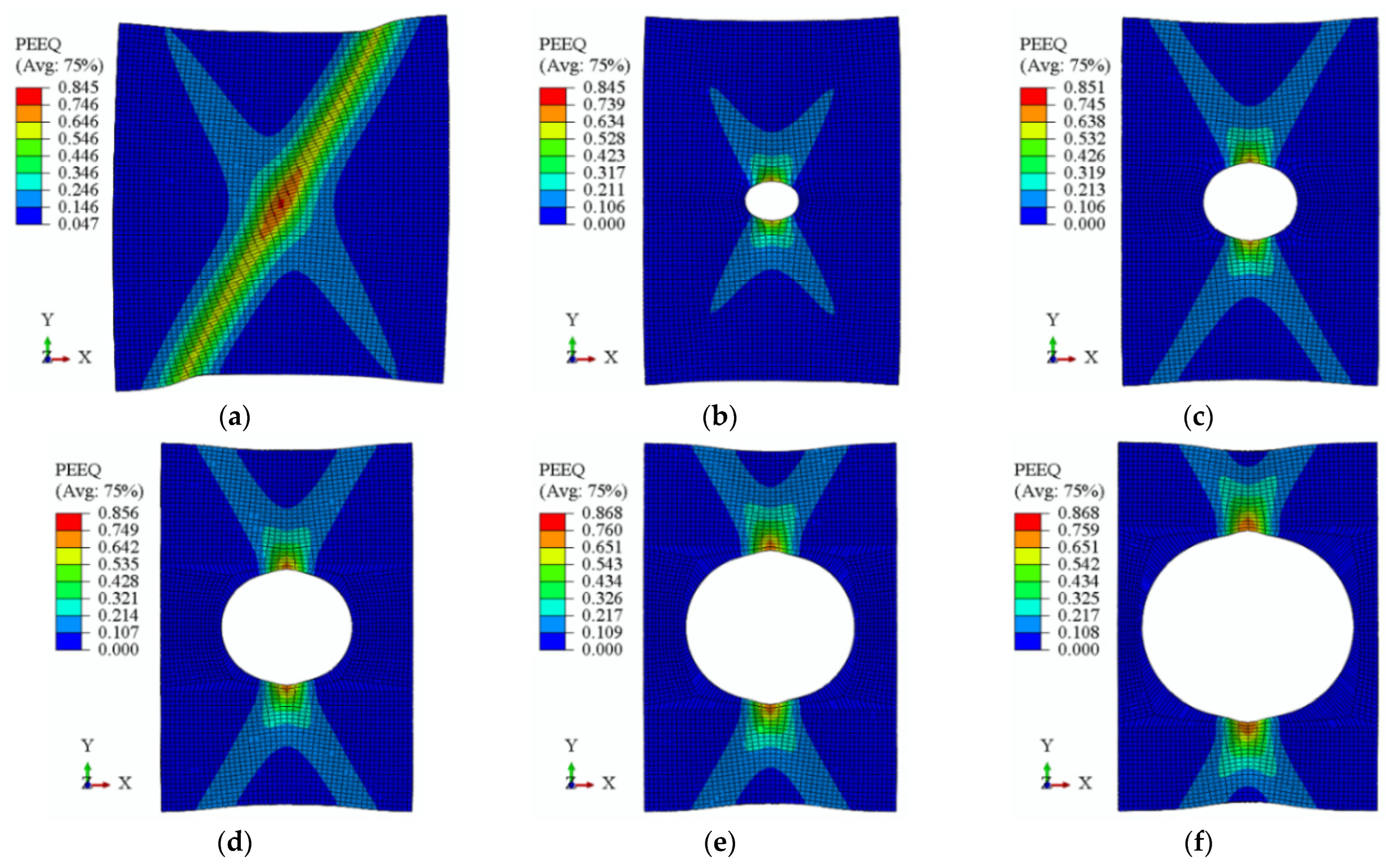
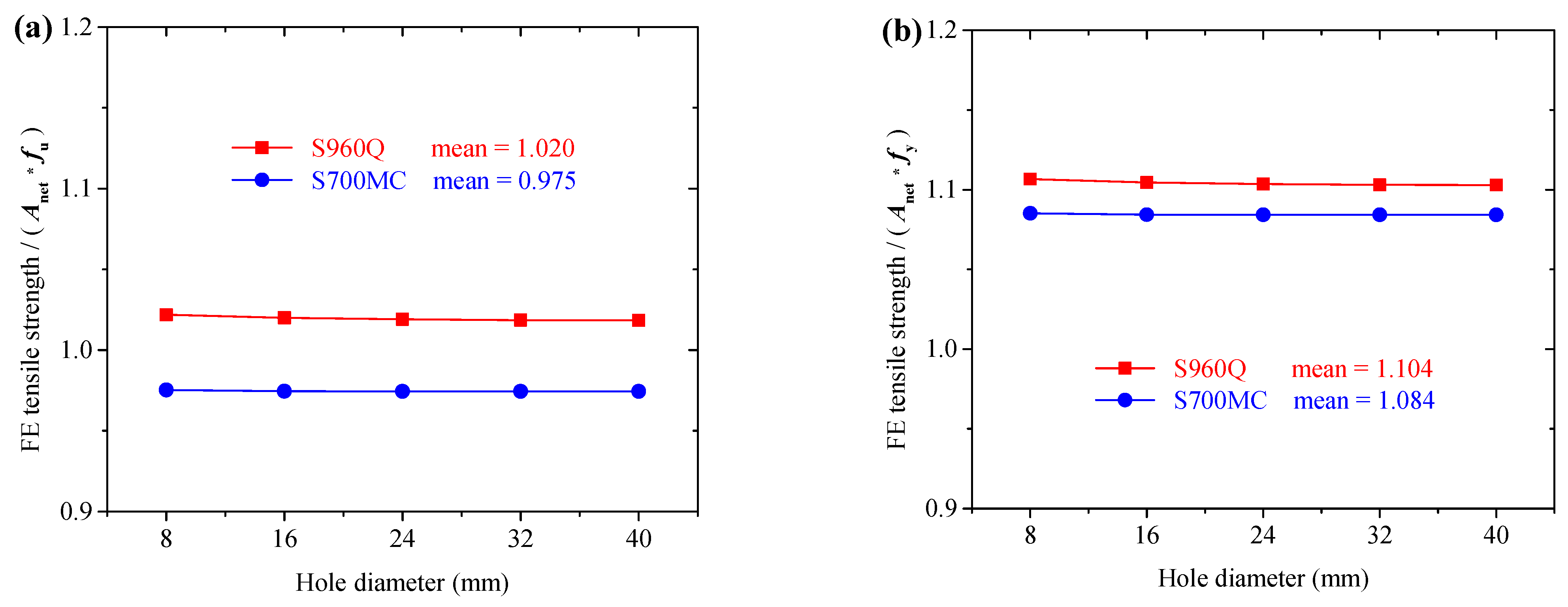
| Material Properties | S700MC | S960Q |
|---|---|---|
| Yield strength fy (MPa) | 710 | 965 |
| Tensile strength fu (MPa) | 790 | 1045 |
| Strain at tensile strength εu (%) | 10.0 | 4.6 |
| Strain at fracture εf (%) | 18.8 | 12.2 |
| Steel | S700MC | S960Q |
|---|---|---|
| σt,u | 919.8 | 1104.6 |
| εt,u | 0.091 | 0.051 |
| a | 919.8 | 1104.6 |
| b | 836.3 | 1048.6 |
| K | 1143.6 | 1284.9 |
| n | 0.091 | 0.051 |
Disclaimer/Publisher’s Note: The statements, opinions and data contained in all publications are solely those of the individual author(s) and contributor(s) and not of MDPI and/or the editor(s). MDPI and/or the editor(s) disclaim responsibility for any injury to people or property resulting from any ideas, methods, instructions or products referred to in the content. |
© 2023 by the authors. Licensee MDPI, Basel, Switzerland. This article is an open access article distributed under the terms and conditions of the Creative Commons Attribution (CC BY) license (https://creativecommons.org/licenses/by/4.0/).
Share and Cite
Tian, Z.; Yang, F.; Wang, S.; Liu, Z.; Chen, A. Plasticity and Ductile Fracture of High-Strength Steel Center-Holed Plates under Tension. Metals 2023, 13, 994. https://doi.org/10.3390/met13050994
Tian Z, Yang F, Wang S, Liu Z, Chen A. Plasticity and Ductile Fracture of High-Strength Steel Center-Holed Plates under Tension. Metals. 2023; 13(5):994. https://doi.org/10.3390/met13050994
Chicago/Turabian StyleTian, Zhijuan, Fei Yang, Sihao Wang, Zhuo Liu, and Ao Chen. 2023. "Plasticity and Ductile Fracture of High-Strength Steel Center-Holed Plates under Tension" Metals 13, no. 5: 994. https://doi.org/10.3390/met13050994
APA StyleTian, Z., Yang, F., Wang, S., Liu, Z., & Chen, A. (2023). Plasticity and Ductile Fracture of High-Strength Steel Center-Holed Plates under Tension. Metals, 13(5), 994. https://doi.org/10.3390/met13050994






